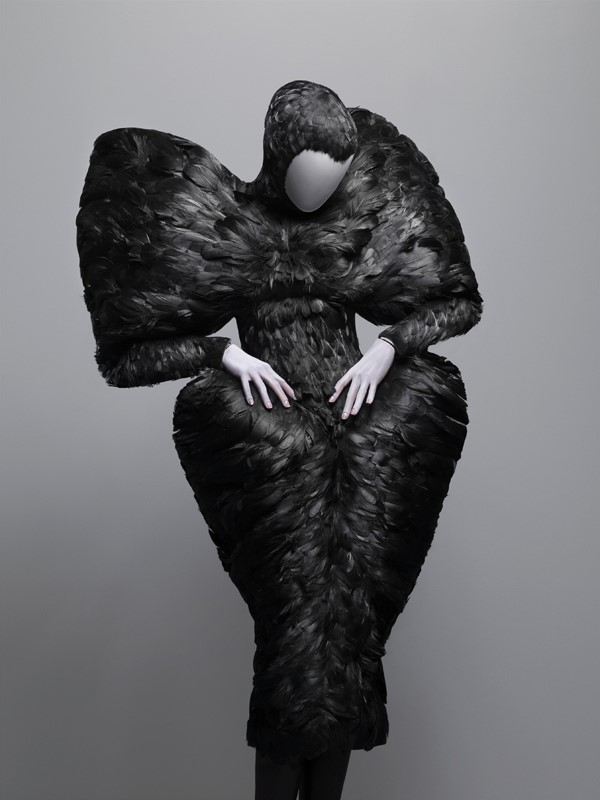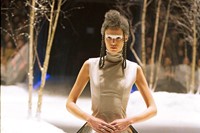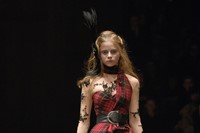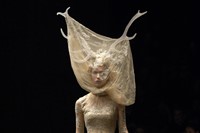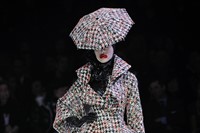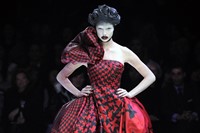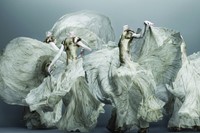Andrew Bolton, curator of Savage Beauty, began his exploration of McQueen’s work by looking at a tattoo on the designer’s upper right arm.
Andrew Bolton, curator of Savage Beauty, began his exploration of McQueen’s work by looking at a tattoo on the designer’s upper right arm. It read, “Love looks not with the eyes, but with the mind” and was taken from Shakespeare’s A Midsummer Nights Dream. In many ways it reflects McQueen’s unique concept of fashion, unconventional ideals of beauty and most importantly it highlights his love of romanticism. Unlike a traditional retrospective, The Metropolitan Museum of Art will examine the complex themes within McQueen’s 19-year career. Showcasing 100 examples of his work from his first runway presentation, Nihilism (1994), to his work at Givenchy and finally the last collection he worked on before his death in February 2010.
AnOther spoke with Andrew Bolton about Alexander McQueen and his closest collaborators.
The title of the exhibition, Savage Beauty, is central to your focus of McQueen’s designs, how did it come about?
Originally the idea came from a book called The Savage Mind by Claude Lévi-Strauss, in which he offers this kind of treatise on two different types of people: ‘the bricoleur’ who is a jack-of-all-trades and ‘the engineer’ who is an artist. I thought both identities tally with McQueen. He looked everywhere for his inspirations and in that sense he was a bricoleur; but he was also a wonderful artist who had a great sense of virtuosity and incredible conceptual complexity, which was shown through his runway presentations. McQueen merged those two identities and that is where the title comes from. Also, in most of McQueen’s collections there were these dichotomies, whether it was to do with beauty and terror, lightness and darkness or life and death. The title is also a play on these contrasts.
Why did you feel now was the appropriate time to exhibit a retrospective of his work?
A few years ago Harold Koda and I had an idea to do a trilogy of exhibitions called Against Nature (which was based on Huysmans' novel of the same title). McQueen was one of the three designers that we were going to feature. Then after his death we decided to do a retrospective of his work, which would really celebrate his contributions to fashion. I suppose we adapted our ideas a little bit, but the exhibition was really as a result of his death last year.
How did you go about organising the exhibition?
It is a retrospective but it is not chronological and is very much organized thematically. Essentially it is based around McQueen’s engagement with romanticism. The starting point came from the idea of the sublime and the 19th century ideals of the sublime. McQueen’s collections ignite this uneasy pleasure where he merges wonder and terror, and that was the original concept of the show. As I continued to work on the exhibition I realised that McQueen engaged more deeply with other philosophical abstractions like individualism, historicism, nationalism, exoticism, primitivism and naturalism. They then became the dominant themes of the exhibition, all of which were recurrent within his collections.
Did you find it daunting at any point?
It was. I was aware that it was very immediate and it came so soon after his death. That was partly very conscious on my part, as I was worried that the archive might be disbanded if we left it too late. Also McQueen had a close team and circle of collaborators and I was worried that they would also be disbanded. I really wanted to understand their memories of McQueen; otherwise it would have been difficult to understand his working process. Having access to people like Sarah Burton was really important and I felt the show would have more integrity if we held the exhibition sooner rather than later as the memories would still be very raw.
How have these collaborators been involved with the exhibition?
I had discussions with Sarah about McQueen’s process and how he put his collections together. They gave me access to the press books, so I read through every article that was ever written about him and a lot of the quotes are used in the exhibition. In a way, I wanted McQueen’s voice to be very present in the show and the quotes either relate to the themes that we explore or directly to garments. McQueen’s shows and presentations were so critical to his creativity and I very much wanted to channel this in the scenography exhibition. I didn’t want to recreate what he did but I wanted to tap into the spirit of it. In that respect I worked very closely with Sam Gainsbury and Joseph Bennett, who are the creative consultants of all of the installations within the show. They have done it so beautifully and have really given priority to the fashions. Because this is the first retrospective after McQueen’s death, I really wanted to examine the artistry of the fashions and the complexities of his runway presentations.
Alexander McQueen: Savage Beauty will exhibit from May 4th – July 31st 2011 at The Metropolitan Museum of Art, New York.
Text by Isabella Burley
